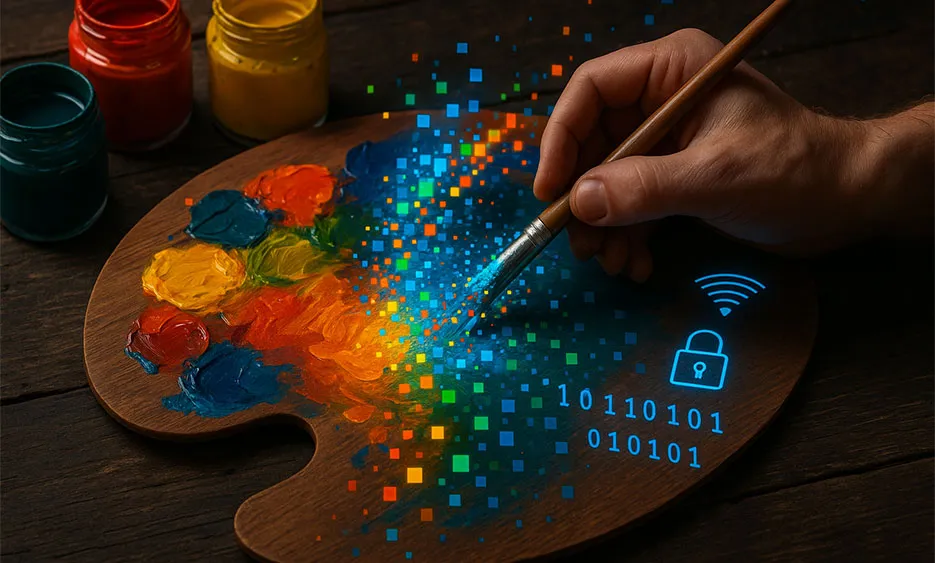
The psychology of colors: How your color palette influences your conversion rate
2. June 2025
The psychology of colors accompanies us daily and evokes emotions. They influence our decisions and often shape our behavior unconsciously. That is why colors play an important role in online marketing. They determine the success or failure of a campaign.
But how does it actually work? How do you choose the right colors for your website, your ads, and email marketing campaigns? This is how you can increase your conversion rate in a long-term and sustainable way.
This article explains the key principles of color psychology in digital marketing. It also shows you how to strategically use your color palette. This benefits you both when working with a full-service agency and in the web design for your business.
Why colors are crucial in online marketing
Colors are not just decorative elements; they also communicate values and create moods. They significantly influence the perception of your brand. Studies show that up to 90% of purchasing decisions are heavily influenced by colors. Especially in email marketing and on landing pages, every second counts to convince users. Therefore, a wrong choice of colors can cause bounces or encourage purchase drop-offs.
- Strengthen brand identity: Colors convey your brand personality and create recognition.
- Evoking emotions: For example, blue conveys trust, while red signals urgency or energy.
- Highlight calls to action: Call-to-action buttons (CTAs) stand out through appropriate contrasts and encourage clicks.
Our full-service agency Media Beats helps you strategically optimize your color palette for greater success in performance marketing. We also support you with web design to achieve optimal results.
The basic colors and their effect on consumers
In online marketing, you should understand the psychology of primary colors. This way, you design your online campaign to be emotional and effective:
- Red: Represents energy, passion, and urgency. It is especially suitable for special offers or limited-time promotions.
- Blue: Symbolizes trust, security, and professionalism. Therefore, many financial and technology companies use it.
- Green: Associated with nature, health, and sustainability. It is ideal for organic products or creates a sense of calm.
- Yellow: Radiates optimism and draws attention. Use it sparingly, however, so it does not overwhelm.
- Orange: Appears dynamic and inviting. That’s why it is often suitable for call-to-action buttons (CTAs).
- Black: Conveys elegance and power. It suits luxury brands well but should be used sparingly.
- White: Represents clarity and simplicity. It creates space and ensures clarity in design.
These associations vary culturally to some extent, but they provide a solid foundation for a successful color strategy. Therefore, they help you to act purposefully in online marketing.
Application of color psychology in web design and email marketing
In web design, it is important to use colors not only for aesthetic appeal but also to drive conversions and engage users. The combination of color harmony and strong contrasts enhances readability and directs attention to relevant content. Example 1: An outdoor clothing webshop uses plenty of green and brown to convey a connection to nature. CTA buttons in orange stand out clearly and encourage purchases.
Example 2: An email newsletter for a financial service uses blue as the main color to convey seriousness. Red accents highlight limited-time offers and increase the click-through rate. Also, in performance marketing, targeted use of color pays off. Ads with contrasting, emotionally fitting colors achieve better click rates. A/B tests with color variants help find the optimal palette for target groups.
Tips for successful color selection for your online campaigns
1. Tips for successful color selection for your 1. Understand your target group: age, gender and cultural background influence color preferences.online campaigns
2. Use colors purposefully: Main colors strengthen your brand, secondary colors set stylish highlights.
3. Use contrasts for CTAs: Buttons and links must be clearly recognizable.
4. Avoid too many colors: Limit yourself to two to three main colors for clarity.
5. Test regularly: color tests (A/B testing) improve conversion and increase effectiveness.
6. Consider accessibility: colors should also be clearly visible for people with visual impairments.
Conclusion
Colors are more than design elements – they shape how customers perceive your brand. They also influence how customers respond to your offerings. Whether in web design, email marketing, or performance marketing: a well-thought-out color strategy sustainably increases your conversion rate. Our full-service agency helps you align your color choices with your target audience and marketing strategies.
Would you like to learn how strategic online marketing can boost your sales? Contact us for a personal consultation.
Our blog
Latest news
With our blog, you are always close to our work, our current projects and the latest trends and developments in web and print.
Any questions?





